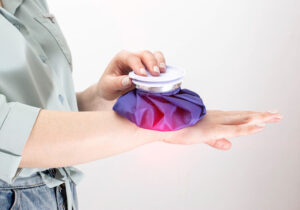De Quervain’s Syndrome may not be a household name, but it’s a condition that’s touching more lives than you think. Characterised by painful inflammation in the tendons on the thumb side of the wrist, it’s a condition that requires the expertise of a specialist for proper diagnosis and treatment.
Local orthopaedic surgeons have been at the forefront of addressing this increasingly common ailment. From office workers to athletes, no one is immune, and the timely intervention of an orthopaedic surgeon in Five Dock can mean all the difference between chronic pain and a swift recovery.
If your wrist aches or feels swollen, understanding De Quervain’s Syndrome is crucial, not just for your comfort but for your overall health and well-being.
What Is De Quervain’s Syndrome?
De Quervain’s Syndrome is a painful condition that occurs when the tendons around the thumb base become swollen and inflamed. The tunnel (sheath) that the tendons run through becomes narrowed, leading to irritation and hindrance in movement.
The pain, often described as sharp or stinging, usually begins at the thumb’s base and can travel up the forearm. It may seem like a small inconvenience, but it can severely limit daily activities.
How do you know if you have De Quervain’s Syndrome? Look out for the following symptoms:
- Pain and swelling near the base of the thumb
- Difficulty moving the thumb and wrist, especially when grasping or pinching
- A “sticking” or “stop-and-go” sensation in the thumb

Common Causes & Risk Factors
Repetitive Motion: Engaging in activities that require continuous wrist movement, such as playing certain sports, typing, or manual labor, can irritate the tendons and lead to this condition.
Inflammatory Conditions: People with chronic inflammatory diseases like rheumatoid arthritis are at a higher risk, as inflammation within the tendons may trigger De Quervain’s Syndrome.
Age and Gender: The syndrome tends to be more prevalent in women, especially during pregnancy or middle age, and in individuals over the age of 30.
Occupational Risks: Jobs that involve repetitive wrist motions, vibrations, or forceful gripping (such as in construction or assembly lines) can significantly increase the risk of developing this condition.
Previous Injury: An injury to the wrist or thumb that has not been properly treated or healed may lead to De Quervain’s Syndrome later on.
Treatment Options
If you’re in the Inner West of Sydney, you have access to some exceptional medical care for this condition. Dr Stuart Kirkham, a renowned orthopaedic surgeon in Five Dock and a specialist in wrist conditions, has helped countless patients overcome De Quervain’s Syndrome. Dr. Kirkham understands the complex mechanics of the wrist and can provide tailored treatment options, ranging from simple physical therapy exercises to surgery if necessary. Finding a local orthopaedic surgeon in Five Dock who knows the nuances of wrist ailments is key to a speedy recovery.
Conservative Measures
When it comes to treating De Quervain’s, a range of options are available. In less severe cases, conservative treatments can often alleviate symptoms and promote healing. Your local orthopaedic surgeon in Five Dock may recommend simples measures such as rest, avoiding activities that worsen the pain, and applying ice to reduce inflammation. You may also be prescribed anti-inflammatory medications to help manage discomfort and swelling.

Cortisone Injections
For some patients, a visit to Dr Stuart Kirkham, a local wrist surgeon with a new clinic in Five Dock, for cortisone injections might be the right choice. This powerful anti-inflammatory medication, injected directly into the affected area, provides targeted relief from pain and inflammation. Many patients find this minimally invasive procedure highly effective in reducing symptoms, allowing them to resume their daily activities with greater ease.
Surgical Intervention
In cases where conservative treatments are not enough, surgical intervention may be considered. Dr Stuart Kirkham’s approach to surgical treatment involves a quick procedure carried out with great precision and care. Taking only around five minutes under general anesthesia in a hospital setting, the results are often rapid and provide long lasting relief.
Post-Surgery Care & Rehabilitation
Proper care post-surgery involves a well-thought-out plan that goes beyond the operating room. After surgery, there will likely be some discomfort. But with the guidance of healthcare professionals, personalised care plans can minimise pain and speed up the healing process. By following specific instructions on keeping the surgical area clean and engaging in gentle exercises, you can set yourself up for success.
When it comes to rehabilitation, recovery from De Quervain’s Syndrome is a process that may take weeks or even months. But the right attitude and practice can turn this potentially frustrating journey into an enlightening and empowering experience.
Rehabilitation often includes physical therapy, where skilled therapists will introduce you to exercises specifically tailored to your condition. They’ll help you regain strength, flexibility, and function in the affected hand. Rehabilitation is like having a roadmap for recovery; it’s there to guide you, step by step, back to normality.

Prevention & Long-term Management
Know Your Limits: If a particular activity makes your wrist ache, it might be time to take a break. Moderation is key.
Ergonomics Matter: Invest in ergonomic tools and office supplies. If you’re typing a lot, an ergonomic keyboard can make a world of difference.
Stretch and Strengthen: Regular exercises to stretch and strengthen your wrists can be a life-saver. Even a few minutes a day can help.
Wear a Brace if Needed: Sometimes, a supportive brace can give your tendons the rest they need to heal.
Talk to a Professional: If in doubt, consult a medical professional. Prevention is often easier with personalised advice.
Take Control Of Your Health Today!
De Quervain’s syndrome may seem like an unmanageable and distressing condition, but the focused care of a specialised wrist specialist can lead individuals back to comfort and regular daily activities. Personalised attention, like the kind provided by Dr. Stuart Kirkham at the Sydney Orthopaedic Surgeon Clinic, is crucial in addressing De Quervain’s syndrome, with treatment strategies meticulously designed to meet the distinct characteristics of the condition.
If De Quervain’s syndrome is disrupting your life, don’t hesitate to reach out to Dr. Stuart Kirkham. With his in-depth knowledge of this particular syndrome and five accessible locations across Sydney, including a new clinic in Five Dock, he’s well-positioned to assist you in your journey toward healing and improving your general health. Always remember to prioritise your well-being, engage in consistent medical check-ups, and seek the guidance of experts like Dr. Kirkham for conditions such as De Quervain’s syndrome, which might be hindering your quality of life.


